By Mike Kuchar
Co-Founder/Senior Research Manager X&O Labs
OL Coach/Run Game Coordinator
Rahway High School (NJ)
Twitter: @MikeKKuchar
In all my time as an offensive line coach, I had been teaching the hinge block on the backside of gap schemes mainly because that is what I knew. I remember giving my lineman the visual of how a door opens and correlating that to how his hips should open to block the interior B gap. Of course, I was not the only one that was teaching this technique. But I found that my lackluster way of teaching it yielded lackluster efforts in return often times letting a backside B gap defender run unobstructed to the ball carrier. It made it seem as if that block wasn’t important to the overall concept.
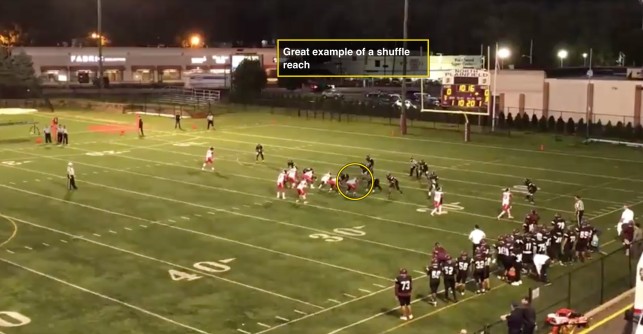
It was only recently that I took what longtime NFL offensive line coach Bill Callahan was doing with teaching the two-step and four-step shuffle reach for uncovered lineman in his zone schemes and incorporated it for my backside Tackle in both zone and gap runs. I found it to be extremely productive for several reasons. For most young players, a shuffle technique is a common movement. It’s something even non-basketball players have done before. Keeping their shoulders squared allowed for greater surface area when making the block. So, this season I made it an effort to implement a shuffle technique for my offensive Tackles on the backside of both zone and gap runs. And in doing so, I’ve found the shuffle reach to be more productive than the hinge for the following reasons:
It’s More Assertive Block Than a Hinge:
The backside hinge was a staple in gap schemes. The Tackle was asked to secure the B gap defender before working out to the C gap. Problem with that is teaching 45 degree step footwork required on the hinge cultivated a weaker block. There wasn’t enough body surface needed to clean up the B gap. First level defensive lineman with tremendous get off were able to dent the B gap and cause problems to the scheme. Using the shuffle reach helped in securing that gap.
It’s Non-Athlete Proof:
I say this all out of love: offensive lineman are not the best athletes on the team. After all, they don’t call them the “big uglies” for a reason. They are a usually an inclusive group of awkward teenagers that don’t get the credit they deserve. We all know this, so they deserve a little more love when we coach them up. I’ve found that just by using this technique instilled confidence in their ability to get their job done and as a result as football players. We had a left tackle this year as a senior that didn’t play a down of varsity football in his career, but at 6-0, 345 pounds with good hands had the potential to be a solid offensive lineman. So naturally, we ran most of our gap and zone schemes away from him and he became a master of the shuffle reach block. Getting 350 pounds plus to move laterally with his shoulders square shut down any thought of penetration in the B gap. As it turns out this same novice was an All-Division selection for us this year.
It’s Effective Against 4i Technique Defenders:
Like many other offensive coordinators, I’m constantly pressed with the task on how to prevent backside B-gap penetration most synoymous in Odd fronts. More than have of our opponents this season operated out of a three-down outfit and not surprisingly the best players along the front played the 4i technique. So, in order to get that B gap sealed off, we would cut our splits down in the B gap with the Tackle and get him reached. And if we couldn’t reach him, we would cut him. This was rarely the case. In most cases, we were able to get the block done.
It Negates Assistance From Center:
Back blocking a 3-technique on power is a hard enough task, but executing the same block against a 4i defender can be nearly impossible. Using the shuffle reach on the backside B gap from the Tackle allowed our Center to stay on the front side of the run game, either by Ace blocking the Nose with the play side Guard (if he’s uncovered) or base blocking the Nose alone.
Shuffle Reach Technique:
Quite simply, the shuffle reach technique is mainly a two-step shuffle footwork with a landmark of the play side “V” of the neck of the B gap defender. Once we have the inside landmark, we work to extend the play side arm (we call this a strong arm technique, many call it a drag hand technique) while working to secure ourselves in the B gap. It’s the same block in principle as a reach block, with the difference being we want out shoulders squared. We felt that was a better way to negate penetration.
Incorporating the Shuffle Reach for Various Concepts:
We were able to implement the shuffle reach technique on the following for the following run concepts:
Power Concept:
Here we were able to double the Nose with the Center and play side Guard. We would turn the C gap defender loose in power and shuffle reach the Tackle. In most cases, he wouldn’t be involved in the play. If he was, we would simply read him and make it a double option concept.
Vs. Even Front
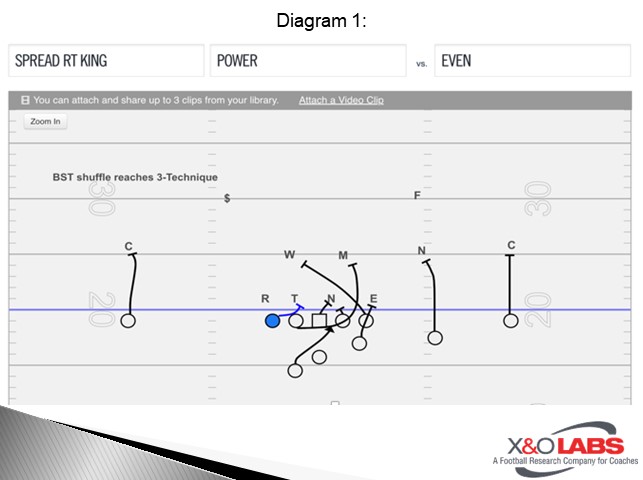
Vs. Odd Front
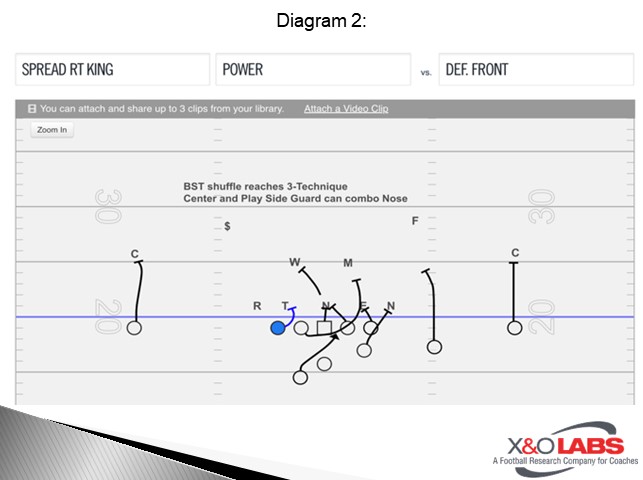
Buck Sweep Concept:
Even though buck sweep mainly hit to the front side, using the shuffle reach with the Tackle allowed the Center to stay on the front side of the scheme. We were able to pick up an extra hat to the play side.
Vs. Even Front
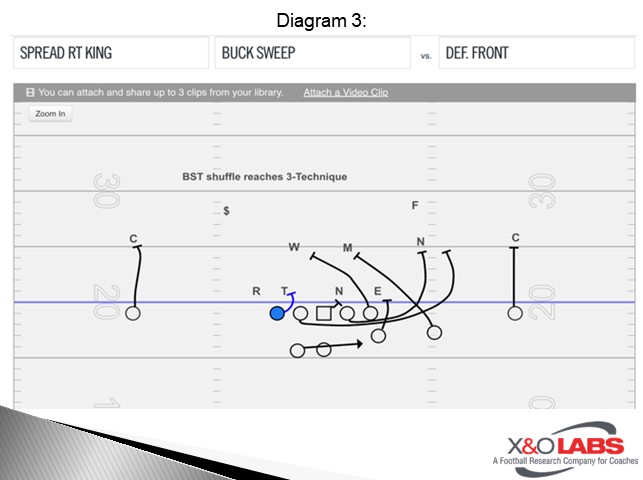
Vs. Odd Front
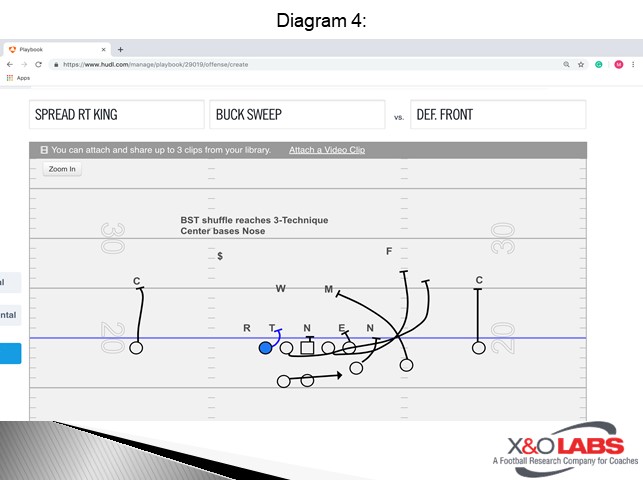
Co-Founder/Senior Research Manager X&O Labs
OL Coach/Run Game Coordinator
Rahway High School (NJ)
Twitter: @MikeKKuchar
In all my time as an offensive line coach, I had been teaching the hinge block on the backside of gap schemes mainly because that is what I knew. I remember giving my lineman the visual of how a door opens and correlating that to how his hips should open to block the interior B gap. Of course, I was not the only one that was teaching this technique. But I found that my lackluster way of teaching it yielded lackluster efforts in return often times letting a backside B gap defender run unobstructed to the ball carrier. It made it seem as if that block wasn’t important to the overall concept.

It was only recently that I took what longtime NFL offensive line coach Bill Callahan was doing with teaching the two-step and four-step shuffle reach for uncovered lineman in his zone schemes and incorporated it for my backside Tackle in both zone and gap runs. I found it to be extremely productive for several reasons. For most young players, a shuffle technique is a common movement. It’s something even non-basketball players have done before. Keeping their shoulders squared allowed for greater surface area when making the block. So, this season I made it an effort to implement a shuffle technique for my offensive Tackles on the backside of both zone and gap runs. And in doing so, I’ve found the shuffle reach to be more productive than the hinge for the following reasons:
It’s More Assertive Block Than a Hinge:
The backside hinge was a staple in gap schemes. The Tackle was asked to secure the B gap defender before working out to the C gap. Problem with that is teaching 45 degree step footwork required on the hinge cultivated a weaker block. There wasn’t enough body surface needed to clean up the B gap. First level defensive lineman with tremendous get off were able to dent the B gap and cause problems to the scheme. Using the shuffle reach helped in securing that gap.
It’s Non-Athlete Proof:
I say this all out of love: offensive lineman are not the best athletes on the team. After all, they don’t call them the “big uglies” for a reason. They are a usually an inclusive group of awkward teenagers that don’t get the credit they deserve. We all know this, so they deserve a little more love when we coach them up. I’ve found that just by using this technique instilled confidence in their ability to get their job done and as a result as football players. We had a left tackle this year as a senior that didn’t play a down of varsity football in his career, but at 6-0, 345 pounds with good hands had the potential to be a solid offensive lineman. So naturally, we ran most of our gap and zone schemes away from him and he became a master of the shuffle reach block. Getting 350 pounds plus to move laterally with his shoulders square shut down any thought of penetration in the B gap. As it turns out this same novice was an All-Division selection for us this year.
It’s Effective Against 4i Technique Defenders:
Like many other offensive coordinators, I’m constantly pressed with the task on how to prevent backside B-gap penetration most synoymous in Odd fronts. More than have of our opponents this season operated out of a three-down outfit and not surprisingly the best players along the front played the 4i technique. So, in order to get that B gap sealed off, we would cut our splits down in the B gap with the Tackle and get him reached. And if we couldn’t reach him, we would cut him. This was rarely the case. In most cases, we were able to get the block done.
It Negates Assistance From Center:
Back blocking a 3-technique on power is a hard enough task, but executing the same block against a 4i defender can be nearly impossible. Using the shuffle reach on the backside B gap from the Tackle allowed our Center to stay on the front side of the run game, either by Ace blocking the Nose with the play side Guard (if he’s uncovered) or base blocking the Nose alone.
Shuffle Reach Technique:
Quite simply, the shuffle reach technique is mainly a two-step shuffle footwork with a landmark of the play side “V” of the neck of the B gap defender. Once we have the inside landmark, we work to extend the play side arm (we call this a strong arm technique, many call it a drag hand technique) while working to secure ourselves in the B gap. It’s the same block in principle as a reach block, with the difference being we want out shoulders squared. We felt that was a better way to negate penetration.
Incorporating the Shuffle Reach for Various Concepts:
We were able to implement the shuffle reach technique on the following for the following run concepts:
Power Concept:
Here we were able to double the Nose with the Center and play side Guard. We would turn the C gap defender loose in power and shuffle reach the Tackle. In most cases, he wouldn’t be involved in the play. If he was, we would simply read him and make it a double option concept.
Vs. Even Front

Vs. Odd Front

Buck Sweep Concept:
Even though buck sweep mainly hit to the front side, using the shuffle reach with the Tackle allowed the Center to stay on the front side of the scheme. We were able to pick up an extra hat to the play side.
Vs. Even Front

Vs. Odd Front










